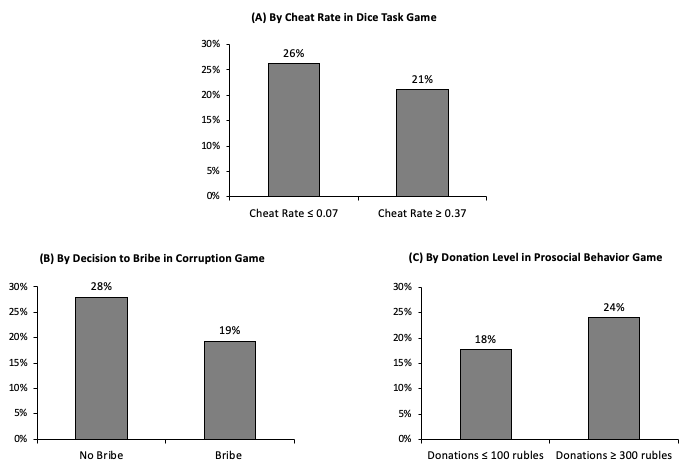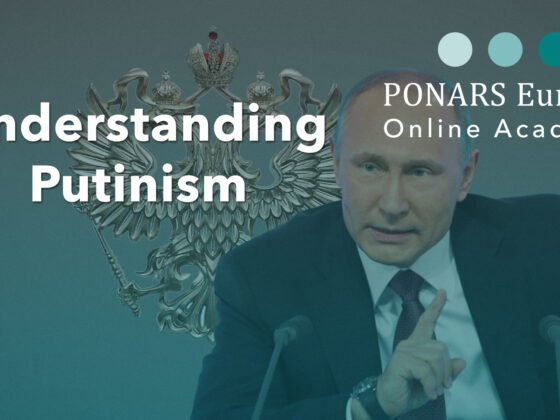(PONARS Eurasia Policy Memo) Among policymakers and scholars, there is a near consensus that corruption—defined as the use of public office or resources for private gain—imposes numerous harms on societies, ranging from reduced levels of investment to declining legitimacy of political institutions. Yet despite high-profile anti-corruption campaigns in many countries around the world, corruption has proved highly resilient. Anti-corruption research and policies have focused primarily on the factors that affect public officials’ willingness to engage in corruption once in office, including low wages, ineffective monitoring, and low levels of transparency. However, a newly emerging research agenda suggests that who chooses to become a public official is also of critical importance for understanding why corruption persists in some countries more than in others. Recent studies using innovative laboratory experiments have found that in countries where corruption is widespread, university students aspiring to the civil service display a greater propensity for dishonesty and corrupt behavior than students pursuing private-sector careers. The opposite holds true in countries with low levels of corruption, where students aspiring to public service are less prone to unethical behavior.
Paradoxically, Russia does not fit this trend. In a recent study conducted together with Alexander Kalgin, Andrei Klimenko, Dmitriy Vorobyev, and Andrei Yakovlev, we found that despite Russia’s high levels of corruption, Russian university students with a propensity to act dishonestly or corruptly self-select out of public sector employment and into the private sector, particularly into sectors such as finance. These findings present something of a puzzle: If individuals who are likely to engage in corruption are self-selecting out of the public sector, then why do high levels of public sector corruption in Russia persist?
Russian Patterns of Self-Selection in Comparative Perspective
Recent research on corruption has begun to look beyond the incentives that shape public officials’ likeliness to act corruptly once in office and focus on the question of who seeks to become a public official in the first place. Drawing on laboratory experiments, studies by Ritwik Banerjee, Tushi Baul, and Tanya Rosenblat and by Remma Hanna and Shing-Yi Wang have found that in the high-corruption context of India, university students aspiring to the civil service are more likely to act dishonestly or corruptly, and less likely to make altruistic donations, than their peers aspiring to careers in the private sector. Expanding this line of research to the post-Soviet region, a forthcoming study I conducted in the high-corruption context of Ukraine produced similar results.
By contrast, Sebastian Barfort and his co-authors found that in the low-corruption context of Denmark, the opposite occurs: Students who have public-sector ambitions are more likely to act ethically and altruistically than their private-sector-oriented counterparts. Taken together, these findings suggest that patterns of self-selection into the public sector play an important role in cross-national variation in levels of corruption. They also point to the need for anti-corruption policies aimed at identifying, recruiting, and retaining high-integrity public-sector employees.
A fair assumption would be that self-selection patterns in Russia, where high levels of corruption are well-documented, should resemble those found in India or Ukraine, not those in Denmark. In 2018, the year in which we completed data collection for our study, Transparency International’s Corruption Perception Index (CPI) ranked Russia 138th out of 180 countries and territories, where a higher ranking indicates lower perceived corruption. Similarly, Transparency International’s Global Corruption Barometer (GCB), which directly polls citizens about their encounters with corruption, found that in 2016—the most recent year for which data are available—34 percent of Russians reported paying a bribe when accessing basic government services.
There is little evidence that corruption in Russia has declined over time, yet substantial shifts have occurred with respect to the appeal of government employment. According to surveys conducted by Russia’s Public Opinion Foundation (FOM), just 6 percent of respondents in 1998 perceived employment in public administration to be a popular career path for Russian youth. By 2011, this figure had risen to 19 percent. Similarly, in the late 2000s, Russian journalists noted a significant increase in applications to study public administration at universities throughout the country, including prominent institutions such as Moscow State University. Reflecting on these trends, none other than Dmitry Medvedev, Russia’s president at the time, publicly suggested in 2011 that rising interest in public sector employment in Russia reflects, at least in part, the intention of young people to exploit public office for personal gain.
Prior to our study, however, there had been little effort to rigorously evaluate propositions about who aspires to public service in Russia and with what motivations, and our findings indicate that Russia does not fit neatly into broader patterns of self-selection from previous studies in other parts of the world.
Experimental Measures of Corruption, Dishonesty, and Altruism
Investigating sensitive topics such as corruption presents challenges, many of which are related to the unreliability of respondents’ self-reported behavior and attitudes. The experimental games employed in our study mitigate these challenges by utilizing incentive payments to reveal participants’ preferences and elicit observable behavior.
To measure propensity for dishonesty, we used a dice task developed by Barfort and colleagues for their study of Denmark introduced above. Respondents were asked to guess a number between 1 and 6 and then self-report whether their guess matched a randomly generated outcome of a dice roll, an exercise that was repeated 40 times. Participants received three times more money for correct guesses, creating an incentive to cheat. The multiple rounds of guesses then facilitated the estimation of individuals’ cheat rates based on a comparison of reported distributions to the expected distribution of successful guesses.
To measure willingness to engage in corruption, we developed a modified version of a laboratory bribe experiment created by Abigail Barr and Danila Serra in which participants are randomly assigned to the role of a citizen or a bureaucrat. The citizen is presented with a scenario in which she can increase her cash payment by offering the bureaucrat a bribe to obtain a permit. Whether participants offer (in the role of citizen) or accept (in the role of bureaucrat) a bribe serves as an indicator of the propensity for corrupt behavior. Finally, to measure prosocial behavior, our study used a modified “dictator game,” a frequently employed tool of experimental economics in which participants received a sum of money which could be retained or donated, fully or in part, to a Russian charity of their choice.
An important question concerns the extent to which behavior in these experimental settings correlates with real-world behavior. Fortunately, as we discuss in our study, abundant evidence indicates that dishonesty in dice-task games is correlated with real-world cheating, fraud, and rule-breaking in schools, the workplace, and prisons, while other research has demonstrated that donations in laboratory games are strong predictors of real-world charitable giving.
Results
We conducted our main study in May and June of 2016 with 804 undergraduate and MA social science students enrolled at one of Russia’s top five universities located in Moscow.[1] To measure career preferences, we asked participants whether after finishing university they would prefer a job in the public sector (gosudarstvennyi sektor) or in the private sector (chastnyi sektor).[2]
As can be seen in Figure 1, there is a clear association between sectoral career preferences and study participants’ behavior in the incentivized experimental games. Panel A in Figure 1 compares career preferences for subjects with an estimated cheat rate of 7 percent or lower (the bottom quartile of the sample) to those of subjects with an estimated cheat rate of 37 percent or higher (the top quartile of the sample).[3] More honest individuals were clearly more inclined to aspire to public service, with 26 percent expressing a preference for public sector employment compared to 21 percent of less honest individuals—a 5 percentage point difference.
The contrast between study participants with a preference for public versus private sector employment was even more clear-cut in the corruption game. Panel B shows that subjects who refused to offer (in the role of citizen) or accept (in the role of bureaucrat) a bribe were 9 percentage points more likely to prefer public sector employment. Meanwhile, Panel C compares sectoral career preferences in the game designed to measure prosocial behavior for subjects who donated 300 or more rubles out of the 400-ruble initial endowment (the top quartile of the sample) to those of subjects who donated 100 or fewer rubles (the bottom quartile of the sample). More altruistic participants were 6 percentage points more likely to prefer a public-sector career path.
These results clearly show that contrary to the findings of earlier studies conducted in the high-corruption contexts of India and Ukraine, Russian university students with a propensity for dishonesty and corruption, and who exhibit low levels of altruism, are less inclined to aspire to public sector employment. In the published version of our study, we demonstrate that these patterns remain robust when using more sophisticated statistical analyses to account for a wide variety of factors that have been shown or hypothesized to influence career preferences, including gender, age, risk aversion, field of study, relatives’ occupations, family income, and ability (as measured by self-reported grade point average and Unified State Exam (EGE) scores).
Figure 1: Correlation Between Sectoral Career Preferences and Dishonesty, Corruption, and Altruism (Percent of Study Participants Preferring Public Sector Employment)

The study also disaggregated different types of public and private sector career paths, revealing that strong preferences for specific careers disproportionately influence the overall sectoral trends. Among public sector careers, the self-selection of high-integrity individuals into Russia’s “budget sector”—non-civil service state employees working in fields such as public health, science, education, and culture—is particularly noticeable, while federal government positions’ appeal to high-integrity individuals is less clear-cut. Meanwhile, while we found evidence that students who are prone to dishonesty or corruption, and who exhibit lower levels of altruism, exhibit stronger preferences for a wide range of private-sector career paths, these patterns were particularly pronounced for the finance sector.
An important caveat to our findings is that our initial study is based on data from a single university. Given that alumni of the Moscow research site occupy important posts throughout the Russian government, our findings from the Moscow study in and of themselves merit consideration. Nevertheless, to examine the generalizability of our results, in December of 2017 and January of 2018, we conducted a second study using an identical research design with 376 students at a regional university. We were able to replicate many of our original findings, which suggests that our study offers insights into trends that extend beyond Russia’s capital city.[4]
Policy Implications
With respect to anti-corruption policies, numerous implications follow from our study. The straightforward lesson is that anti-corruption efforts must feature public-sector campaigns to recruit, screen, and retain high-integrity employees. Additionally, the seemingly paradoxical findings about Russia—in which the patterns of corrupt self-selection observed in India and Ukraine are not apparent, yet public sector corruption persists—point to the need for further research on the interactions among corruption, public service, and state capacity.
One issue to consider is whether the universities where we conducted our studies are outliers, or what scholars Monica Prasad, Mariana Borges Martins da Silva, and Andre Nickow refer to as “islands of integrity,” government institutions or agencies within an otherwise corrupt system where social norms of probity prevail. Though our similar results at multiple universities cast doubt on this interpretation of our findings, the determination that our research sites are, in fact, unique would suggest the importance of identifying additional outliers and distilling best practices from these organizations.
A second possibility consistent with our findings is that corruption in Russia stems more from the transformation of public officials’ behavior after joining the civil service and less from patterns of self-selection into the public sector. If true, then the case of Russia draws attention to the importance of identifying optimal allocations of limited resources across screening for high-integrity applicants to public-sector jobs versus incentivizing high-integrity behavior for public servants once in office, and how the optimal use of anti-corruption resources might vary across countries.
A third consideration is that the results of our study may attest in part to the lack of scruples of those pursuing private-sector careers in Russia rather than to the scrupulousness of individuals self-selecting into the public sector. While it would still seem normatively desirable to have relatively more dishonest citizens seek profit in the private sector rather than from direct abuse of public resources, this interpretation of our findings suggests that anti-corruption efforts should focus not only on bureaucrats’ extortion of bribes but also on private sector actors’ willingness to engage in corrupt transactions.
A final interpretation that reconciles the coexistence of a corrupt bureaucracy with the self-selection of public-service-oriented individuals into the public sector focuses on the nature of the Russian state and emphasizes distinctions among different types of public-sector careers. As political scientists such as Brian Taylor and Daniel Treisman have emphasized, many elites engage in self-enrichment in contemporary Russia while also implementing policies to improve state capacity and citizen welfare. In line with this interpretation, our study found, as noted above, that the correlation between altruistic motivations and public-sector employment are strongest for the students aspiring to budget sector positions and weakest for students aspiring to federal government careers. Arguably, idealistic youth may be drawn to street-level bureaucratic roles in Russia’s welfare, public health, scientific, education, or cultural sectors despite—rather than because of—public sector corruption. It follows that in countries with complex bureaucracies such as Russia, successful anti-corruption efforts will need to disaggregate the state and customize anti-corruption policies to specific sectors, ministries, or agencies.
Our study shows that even in countries with widespread corruption, there may exist significant pockets of aspiring civil servants motivated by public service ideals rather than self-enrichment. To understand why corruption persists and how to effectively fight it, much more attention needs to be paid to who chooses to become a public official, not just the incentives public officials face once in office.
Jordan Gans-Morse is Associate Professor in the Department of Political Science at Northwestern University.
[1] All participants in the Moscow study received a minimum of 500 rubles and could earn up to 2,000 rubles. On average, participants received approximately 1,050 rubles, or approximately $14 at the time of the study.
[2] In the two years following our Moscow study, we re-contacted students who had graduated and confirmed that our career preference variables are robust predictors of post-graduate employment: Participants expressing a preference for the public sector at the time of the initial study were approximately 30 percentage points more likely to be employed in the public sector at the time of the post-graduation survey.
[3] An estimated cheat rate of 7 percent indicates that a participant most likely self-reported dishonestly on fewer than 1 in 10 dice roll results; a rate of 37 percent, that a participant most likely self-reported dishonestly on more than 1 in 3 dice roll results.
PONARS Eurasia Policy Memo No. 721











